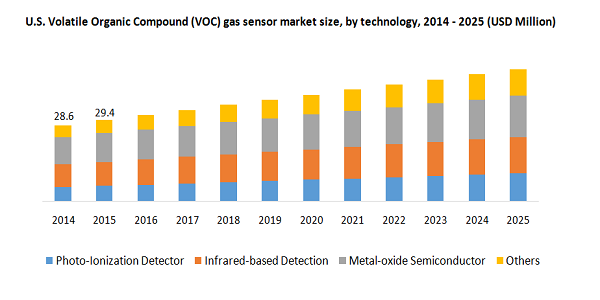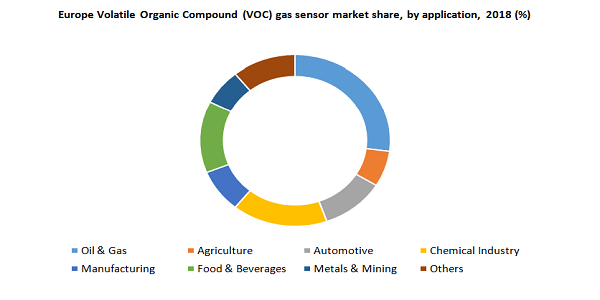- US: +1-408-610-2300
- Toll Free: +1-866-831-4085
- Become a Client
The global volatile organic compound (VOC) gas sensor market size was accounted for USD 141.7 million, in 2018 and is anticipated to grow at a CAGR of 4% over the forecast period of 2019 to 2025. These sensors basically measure the concentration of various gases in their surroundings like benzene, methylene chloride, acetone, ethanol, and ethane. Rising awareness regarding air pollution is one of the major drivers of the product. The demand for sensors is projected to rise because of the increased detection of toxic or explosive gases at unharmed distances.
The rising imposition of stringent measures and regulations by government organizations like the Mine Safety and Health Administration (MSHA) and the U.S. Environment Protection Agency (EPA) have led to wide-scale adaption in several industries. The VOC sensors are small in size and can be conveniently installed in rigid environments. In addition, manufacturers are concentrating on producing sensors that are firm and have improvised electronic features, and can give real-time information concerning on-field activities.

Rising awareness regarding outdoor and indoor air quality is propelling the product demand in both private and industrial environmental monitoring. The VOC gas sensors are installed in industries. They have very low efficiency and consume a lot of power at high temperatures. Therefore, the demand for sensors consuming less power and with higher efficiency levels is one of the major drivers of the industrial sensor market.
New technologies like non-dispersive Infrared (NDIR) sensors for combustible gas, various types of substance-specific electrochemical sensors, and Photo Ionization Detectors (PIDs) for measurement are majorly available for integrating into multi-sensor portable instruments. VOC sensors are primarily used in the gas and oil industry to ascertain if there are any leaks in drilling platforms (upstream), tanker and trailers vessels (midstream), storage and refining facilities (downstream), and pipelines.
Developments in flexible electronics, miniaturized systems, and wireless sensors have propelled the growth of the market. However, an increase in the adaption of wireless devices with the help of the Internet of Things (IoT) may restrain the market of wired VOC gas sensor market in the coming few years.
Single gas detection sensors ascertain the presence of one gas at a time and are mostly used in automotive applications. They are most suitable for the detection of gases like acetone, xylene, butadiene, methylene chloride, benzene, tetrachloroethylene, toluene, and other combustible gases. Each and every process involved in the production and manipulation of hydrocarbons emits VOC gases. As a consequence of which, it is used in industrial applications like oil refining, petrochemical plant, and chemical processing.
Multiple gas detection sensors are majorly used in the gas and oil sector because of their cost-effectiveness and portability. These detectors are conventionally used in monitoring pipeline activities and detecting various gases like MTBE, formaldehyde, perchloroethylene, benzene, and methylene chloride. Additionally, these sensors are installed as VOC analyzers to detect leakage in components like valves, connectors, pumps, open-ended lines, and compressors. Moreover, they are also used for checking fugitive emissions in Method 21.
Metal oxide semiconductor gas sensors function when VOC gas happens to be in contact with the metal oxide surface where reduction or oxidation of the gas changes resistivity or conductivity of the metal oxide surface. An electronic circuitry enables the measurement of the change in resistivity or conductivity. These products are available at affordable prices and can detect the presence of hazardous combustible gases. They are majorly used in industries like medical, petrochemical, and automotive because of their advantageous features like longevity and resistance to corrosion. In 2018, semi-conductor technology-based sensors attributed to a significant part of the market share.
The very benefit of installing IR gas sensors is that their detector does not come in contact with the gas directly. The gases are detected by using infrared radiation. The sensors include detectors, optical filters, and IR sources. However, the price of these sensors ranges from USD 250 to USD 300 per product, which is comparatively higher than that of electrochemical sensors.
Sensors are installed in gas and oil industries are to ensure safety and health apart from reaching optimal levels of production. As a consequence, the usage of VOC sensors is expanding at an accelerating pace for monitoring of pipelines, real-time tracking of reservoir environment, remote monitoring of plant equipment, and monitoring of benzene leaks. Additionally, technological developments in multi-node collaborations, smart nodes, and error tolerance are propelling the growth of the volatile organic compound gas sensor market. Rising demand for petroleum and natural gas has led to probable risks involved during production like exposure to hazardous and combustible gases during gas leakage and extraction.

The food and beverage production industry is anticipated to witness the accelerating adaption of smart manufacturing initiatives and digital transformation in the upcoming years. This growth is attributed to the rise in the number of food processing companies, which are functioning over the value chain. The installation of VOC sensors in food materials for ascertaining the presence of VOC gases has further driven the demand for the product.
In 2018, Europe dominated the market because of increasing investments in IT and the development of advanced sensor technologies. Increasing demand for sensors that can be monitored through handheld devices has supported advancements in technology. The government is currently focusing on emission control standards and energy efficiency that has driven the product demand in the automotive industry of Europe. The growing application of sensors in several industries along with rising opportunities is projected to propel the growth of the regional market.
The Asia Pacific is expected to grow as the fastest developing region due to the rising industrial automation in countries like India, Japan, and China. These countries use sensors extensively in their petrochemical and chemical and gas and oil industries due to their rapid response to the leakage of combustible gases.
Key players in the market include City Technology Ltd.; ABB Ltd; Aeroqual Limited; Siemens AG; Integrated Device Technology, Inc.; Bosch Sensortec; EcoSensors; GfG Europe Ltd and SGX Sensortech. Sensor producers concentrate on investing in R&D to develop technologically advanced products with an aim to boost the market growth. They have adapted launching new products as their prime developmental strategy to meet the demand of the end-users. Moreover, they have acquired businesses in order to expand their product line and to accelerate the process of production for expanding sales in various geographical locations.
|
Attribute |
Details |
|
The base year for estimation |
2018 |
|
Actual estimates/Historical data |
2014 - 2017 |
|
Forecast period |
2019 - 2025 |
|
Market representation |
Revenue in USD Million & CAGR from 2019 to 2025 |
|
Regional scope |
North America, Europe, Asia Pacific, Central & South America, Middle East & Africa |
|
Country Scope |
U.S., Canada, Mexico, U.K., Germany, China, India, Japan, Brazil |
|
Report coverage |
Revenue forecast, company ranking, competitive landscape, growth factors, and trends |
|
15% free customization scope (equivalent to 5 analyst working days) |
If you need specific information, which is not currently within the scope of the report, we will provide it to you as a part of the customization |
This report forecasts revenue growth at global, regional, and country levels and provides an analysis of the latest industry trends in each of the sub-segments from 2014 to 2025. For the purpose of this study, Million Insights has segmented the global VOC gas sensor market report on the basis of type, technology, application, and region:
• Type Outlook (Revenue, USD Million; 2014 - 2025)
• Single Gas Detection Sensor
• Multiple Gas Detection Sensor
• Technology Outlook (Revenue, USD Million; 2014 - 2025)
• Photo-Ionization Detector (PID)
• Infrared-based Detection
• Metal-oxide Semiconductor
• Others
• Application Outlook (Revenue, USD Million; 2014 - 2025)
• Oil & Gas
• Agriculture
• Automotive
• Chemical Industry
• Manufacturing
• Food & Beverages
• Metals & Mining
• Others
• Regional Outlook (Revenue, USD Million; 2014 - 2025)
• North America
• U.S.
• Canada
• Mexico
• Europe
• U.K.
• Germany
• the Asia Pacific
• China
• Japan
• India
• South America
• Brazil
• Middle East & Africa


Research Support Specialist, USA